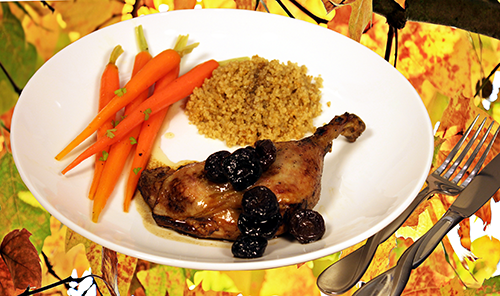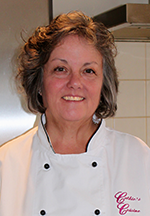quinoa, glazed carrots, pear and ginger upside cake
I love duck. It is so rich and flavourful and this is the perfect dish for fall. Full of great flavours and hearty enough to warm the soul when the weather starts to turn cooler. This is also a great dish to cook on a workday as you can start the cooking first thing in the morning and leave the duck cooking all day. When you get home, you just need to finish the sauce and the side dishes. If you don’t want to leave your oven on all day, you can reduce the cooking time and increase the temperature – say 350°F for 2 hours.

4 duck legs, thawed
Salt and pepper as required
¼ cup Balsamic vinegar
Water as required
Season both sides of the duck legs and place, skin side up, in a pan just large enough to hold them. Pour the vinegar down the sides of the legs and add just enough water to come half way up the duck. Cover and place in a 190°F oven.
Roast for 6 – 9 hours. Remove the duck from the pan and place them on a baking tray. Turn the temperature of the oven to 450°F. Roast the legs just long enough to crisp up the skin, approximately 15 minutes. Make the sauce and finish the side dishes while the skin is crisping up.
Carefully remove as much of the fat from the pan juices as possible. I like to use one of those jugs that allows the fat to rise to the surface while the juices remove on the bottom so you can pour them off.
While the duck is cooking, reconstitute ¼ cup dried cherries in just enough warm water to cover for 10 minutes.
Return the juices to the pan and add the cherries and water used to reconstitute the cherries as well. Simmer to reduce the juices so it is thick and syrupy, approximately 10 minutes. Taste and adjust the seasonings.
Spoon some of the cherries over top of the duck legs and serve the jus on the side.
Quinoa
I think this is a great side dish for the duck legs. It absorbs the juices perfectly and is quick and easy to cook.
1 cup quinoa
2 cups water
½ tsp salt
Place all of the above in a pan with a tight fitting lid. Bring to a boil then reduce the heat to low. Simmer the quinoa just until it is soft and has absorbed all of the water, approximately 20 minutes. Fluff with a fork and serve alongside the duck legs.
Glazed carrots
All the prep for this dish can be done in advance, even cooking and cooling the carrots. If you are going to cook the carrots in advance, be sure to under-cook them so they are not overcooked in the final dish.
Use two bunches of small carrots. Peel and trim the root end off but leave some of the top greens as they look very attractive.
2 bunch carrots (approximately 18 oz or 14 carrots)
Water to cover
¼ tsp salt
1 tablespoon butter
Juice of a half lemon
2 tablespoons honey
Fresh ground pepper
Bring a pot of water to the boil. Add the salt and then add the carrots. Cook just until the carrots are tender crisp, approximately 5 minutes. Drain the carrots well.
Melt the butter in a frying pan just large enough to hold the carrots. Add the carrots and the rest of the ingredients. Shake the pan well to coat the carrots with the glaze. Cook just until the carrots are well glazed and the glaze has reduced by half. Taste and adjust the seasonings. Garnish with fresh chopped parsley.
Pear and Ginger upside down cake

4 tablespoons butter, plus extra for greasing pan
½ cup dark brown sugar
2 large pears peeled, cored and thinly sliced
Melt butter in a small saucepan. Add the brown sugar and simmer over moderate heat, stirring, four minutes. Remove from heat and pour into the bottom of a 10”round cake pan. Arrange the pear slices attractively on top of the caramel.
½ butter, at room temperature
½ cup sugar
½ cup brown sugar
Using a mixer, blend the butter and the sugars on medium-low speed. Increase the speed to high and cream until light and fluffy.
1 large egg
¾ cup milk
¼ cup sour cream
2 teaspoons freshly grated ginger
In another bowl, whisk together the above ingredients.
2 cups flour
1 teaspoon baking soda
½ teaspoon salt
1 teaspoon cinnamon
In a separate bowl, mix together the dry ingredients.
Starting first with the dry ingredients add ⅓ of the flour mixture into the butter mixture. Then add ½ of the egg mixture and mix just to incorporate. Don’t over-mix. Repeat until the all of the ingredients are used.
Carefully pour the batter into the pan being sure not to disturb the pears. Bake in a preheated 375°F oven just until a wooden tester inserted into the centre of the cake comes out clean. Let cool on a rack for 10 to 15 minutes, and then turn out onto a serving platter. Serve warm with softly whipped cream.
 Cathie Hamilton
Cathie Hamilton
Certified Culinary Scientist
E-mail Cathie Hamilton
See all articles by Cathie Hamilton



